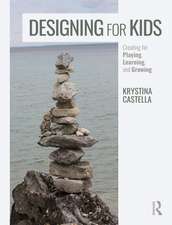Adaptive Sensory Environments: An Introduction
Autor Maria Lorena Lehmanen Limba Engleză Paperback – 15 aug 2016
Adaptive Sensory Environments: An Introduction presents a cutting-edge methodology for adaptive sensory design by fostering an inter-disciplinary approach in which aspects of neuroscience, biophilia, captology, nanotechnology, kinetics, and sensemaking all play critical roles in helping adaptive architecture "tune" to occupants. Furthermore, the book illustrates how adaptive sensory environments transform and uplift quality of life in entirely new ways, by strategically unlocking the potential that technological innovations bring. By teaching scholars, researchers, practitioners, specialists, and consultants how to design architecture that guides what emerging interactive technology can do, it allows them to see deeper into an architectural design, to extend beyond interaction and, ultimately, to build environments that adapt by changing and growing with their occupants’ immediate needs and long-term goals.
| Toate formatele și edițiile | Preț | Express |
|---|---|---|
| Paperback (1) | 322.89 lei 6-8 săpt. | |
| Taylor & Francis – 15 aug 2016 | 322.89 lei 6-8 săpt. | |
| Hardback (1) | 988.13 lei 6-8 săpt. | |
| Taylor & Francis – 18 aug 2016 | 988.13 lei 6-8 săpt. |
Preț: 322.89 lei
Preț vechi: 416.20 lei
-22% Nou
Puncte Express: 484
Preț estimativ în valută:
61.79€ • 64.97$ • 51.05£
61.79€ • 64.97$ • 51.05£
Carte tipărită la comandă
Livrare economică 16-30 aprilie
Preluare comenzi: 021 569.72.76
Specificații
ISBN-13: 9781138641426
ISBN-10: 1138641421
Pagini: 202
Ilustrații: 58
Dimensiuni: 156 x 234 x 20 mm
Greutate: 0.39 kg
Ediția:1
Editura: Taylor & Francis
Colecția Routledge
Locul publicării:Oxford, United Kingdom
ISBN-10: 1138641421
Pagini: 202
Ilustrații: 58
Dimensiuni: 156 x 234 x 20 mm
Greutate: 0.39 kg
Ediția:1
Editura: Taylor & Francis
Colecția Routledge
Locul publicării:Oxford, United Kingdom
Public țintă
Postgraduate, Professional, and UndergraduateCuprins
Acknowledgments. Introduction. 1. Counter-Productive Design 2. Living Information 3. Kinetic Frontiers 4. Unfolding Transience 5. Spatial Dynamics 6. Building Perceptions 7. Design for the Senses 8. Architecture That Learns 9. Architecture That Teaches 10. Plasticity for Growth 11. Nano Possibilities 12. Building Personalization 13. Influence by Design 14. Transformation to Fulfillment 15. Authoring Adaptive Systems 16. Integrating Nature 17. Overarching Goals 18. Success Factors 19. Collective Behaviors 20. Network Communication 21. Design Process 22. Design Capabilities 23. Spirit of Place 24. Future Impact Bibliography. Index
Notă biografică
Maria Lorena Lehman is the Founder of the Sensing Architecture ® Academy. She is recipient of the Harvard University Digital Design Prize, and holds degrees from both Virginia Polytechnic Institute, US and the Harvard University Graduate School of Design, US. Lehman is internationally published and in numerous periodicals, including Architect Magazine and Forbes. To learn more, visit SensingArchitecture.com.
Recenzii
'Maria Lorena Lehman has established a formidable international reputation as a researcher and teacher of multi-sensory design. All her work is devoted to enhancing the human experience when working and living in buildings. This book continues to explore this motive and shows her keen awareness of the lessons from the past and current trends in foreseeing the future for architecture. It is full of creative thought. She examines how technology, nature, learning from other design sectors and many other aspects can harness benefits for occupants and in this way transform architectural design. This is a book students, academics and professionals in practice should embrace and I believe will relish.' - Derek Clements-Croome, Professor Emeritus, School of the Built Environment, Reading University, UK
Descriere
Adaptive Sensory Environments presents a cutting-edge methodology for adaptive sensory design by fostering an inter-disciplinary methodology in which aspects of neuroscience, biophilia, captology, nanotechnology, kinetics, and sensemaking all play critical roles in helping adaptive architecture "tune" to occupants.

















